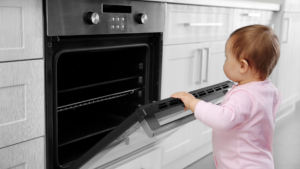Creating a Safe Haven: Tips for Keeping Your Home Safe for Kids

As parents, nothing matters more than the safety and happiness of our children. Our homes should be a sanctuary where they can explore, play, and grow without unnecessary risks. Let’s dive into some key tips to help you create a safe and fun environment for your little ones.
1. Baby-Proofing Magic
Baby-proofing might sound daunting, but it’s essential for those early years of exploration. Think of it as turning your home into a fortress of safety! Install baby gates at stairways, add corner protectors on sharp furniture edges, and secure heavy items like bookshelves and TVs to the walls.
2. Electrical Safety Tricks
Outlets are like magnets for tiny fingers. Cover them with safety plugs or plates to keep curious kids safe. Hide electrical cords out of reach and avoid overloading sockets to prevent electrical fires.
3. Play Zone Perfection
Create a designated play area free from sharp objects and small toys that could be choking hazards. Regularly inspect toys for damage and ensure they’re age-appropriate. This will give you peace of mind while your kids play.
4. Poison Patrol
Store household cleaners, medications, and chemicals out of reach or in locked cabinets. Keep the Poison Control number (1-800-222-1222 in the U.S.) handy and teach older kids about the dangers of ingesting unknown substances.
5. Fire Safety Savvy
Install smoke detectors in every bedroom and on each floor. Test them monthly and replace batteries annually. Create and practice a fire escape plan with your kids so they know exactly what to do in case of an emergency.
6. Water Watchfulness
Never leave children unattended around water, whether it’s the bathtub, pool, or even a bucket. Install locks on toilet lids and keep bathroom doors closed. If you have a pool, ensure it’s fenced and has a self-latching gate.
7. Window and Balcony
Install window locks or guards to prevent falls and keep furniture away from windows to discourage climbing. Ensure balcony railings are secure and there are no gaps that kids could squeeze through.
8. Kitchen Safety
The kitchen is a hub of activity and potential hazards. Use stove knob covers and keep pot handles turned inward. Store sharp utensils and hot appliances out of reach, and never leave cooking unattended.
9. Anchor Heavy Items
Secure bookshelves, TVs, and other heavy objects to the wall to prevent them from tipping over. Keep heavy items on lower shelves to reduce the risk of injury if they fall.
10. Emergency Prep 101
Teach your children how to dial emergency numbers and what to say. Have a first-aid kit easily accessible and ensure babysitters or caregivers know where it is and how to use it.
11. Regular Home Check-Ups
Conduct regular inspections of your home to spot and fix potential hazards. Look for loose railings, exposed wires, and other risks that might go unnoticed in daily life.
12. Education and Supervision
Teaching kids about safety rules is as important as implementing them. Make sure they understand why safety measures are in place. Always keep an eye on young children and be aware of their surroundings.
Creating a safe home doesn’t have to be overwhelming. With these tips, you can ensure your home is a safe haven where your kids can thrive and play. Regular maintenance and a watchful eye are key to keeping your home secure and joyful for your family.
Your home is more than just a building; it’s a place where memories are made. Let’s make sure those memories are safe and happy ones!
